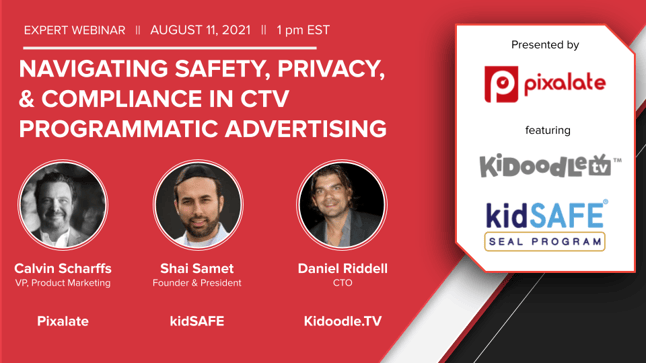

Pixalate recently hosted a webinar covering the issues lurking beneath the surface of the booming Connected TV (CTV) advertising space: Consumer Privacy, COPPA compliance, and brand and family safety. Read this recap to learn how to address these challenges.
Featured speakers included:
You can watch the full recording of the webinar on YouTube here:
Nearly 90% of all Apple App Store and Google Play Store apps target children under 12 as their potential audience, according to Pixalate’s H1 2021 measurements. Interestingly, 10% of them are privately registered, so there is no data about the actual publisher.
Moreover, 16-22% of all apps have no detectable privacy policy, according to Pixalate’s figures. Google announced that it will require all apps from the Play Store to have a privacy policy implemented by April 2022. Apple claims that it already requires iOS apps to do so. However, 16% of all apps listed in the App Store did not have a detectable privacy policy.
Shai Samet, president and founder of kidSAFE, noted that we have observed increased enforcement of privacy regulations in the advertising industry, particularly COPPA (Children’s Online Privacy Protection Act) and GDPR (General Data Privacy Regulation). Samet pointed out that even unintentional breaches of COPPA could be punished, and GDPR violations could be very severe for organisations, reaching hundreds of millions of dollars.
Samet also cautioned companies operating on a global scale to remember regional privacy laws, such as Brazil’s LGPD, the United Kingdom’s AADC, or China’s PISS. Also, in the American market, there are a variety of state privacy regulations, including CCPA (California), CDPA (Virginia), and CPA (Colorado), with more potentially on the way
Samet’s prediction for the future? “We're going to see the need for a federal privacy bill.”
According to Dan Riddell, CTO of Kidoodle.tv, there are many misconceptions around children advertising:
"You are allowed to track data to understand how your campaigns are performing for understanding, such as service analytics, and similar. What you're not allowed to do is target against those data points," explained Riddell.
According to Riddell, the key to successful campaigns for children is contextual advertising, as you cannot target based on behavioral characteristics. Moreover, it is essential to distinguish between devices used to watch the content.
Kidoodle.TV’s data shows that at least 70% of the time, parents are within earshot of programming that children are watching, and over 50% of the time are actively co-viewing in the same room with their kids on CTV devices, Riddell said during the webinar.
However, on mobile devices, almost always the audience contained only children. It is crucial to remember that and deliver content compelling for all viewers.
Both Samet and Riddell shared best practices for OTT/CTV advertising in child-friendly environments:
The last time COPPA was updated was 2013, and Samet says it has become “obsolete” in many ways since then. The last rule review of COPPA was announced in 2019, and Samet predicts that we can expect a new version of COPPA by some time in 2022. Moreover, according to Riddell, COPPA will probably still focus on contextual advertising, which could be considered beneficial, especially with the development of AI and machine learning helping to understand various contexts.
We can also expect further restrictions as new laws emerge or are updated, including potentially expanding COPPA protection to children under 16 (up from 13). Also, the FTC may be more active in regulating the industry and already looks at biometrics as another aspect to control.
Disclaimer
The content of this blog, and the Publisher Trust Indexes (collectively, the “Indexes”), reflect Pixalate’s opinions with respect to factors that Pixalate believes may be useful to the digital media industry. The Indexes examine programmatic advertising activity on mobile apps and Connected TV (CTV) apps (collectively, the “apps”). As cited in the Indexes and referenced in the Indexes’ key findings reproduced herein, the ratings and rankings in the Indexes are based on a number of metrics (e.g., “Brand Safety”) and Pixalate’s opinions regarding the relative performance of each app publisher with respect to the metrics. The data is derived from buy-side, predominantly open auction, programmatic advertising transactions, as measured by Pixalate. The Indexes examine global advertising activity across North America, EMEA, APAC, and LATAM, respectively, as well as programmatic advertising activity within discrete app categories. Any insights shared are grounded in Pixalate’s proprietary technology and analytics, which Pixalate is continuously evaluating and updating. Any references to outside sources in the Indexes and herein should not be construed as endorsements. Pixalate’s opinions are just that, opinions, which means that they are neither facts nor guarantees; and neither this press release nor the Indexes are intended to impugn the standing or reputation of any person, entity or app.
*By entering your email address and clicking Subscribe, you are agreeing to our Terms of Use and Privacy Policy.
These Stories on Webinar
*By entering your email address and clicking Subscribe, you are agreeing to our Terms of Use and Privacy Policy.

Disclaimer: The content of this page reflects Pixalate’s opinions with respect to the factors that Pixalate believes can be useful to the digital media industry. Any proprietary data shared is grounded in Pixalate’s proprietary technology and analytics, which Pixalate is continuously evaluating and updating. Any references to outside sources should not be construed as endorsements. Pixalate’s opinions are just that - opinion, not facts or guarantees.
Per the MRC, “'Fraud' is not intended to represent fraud as defined in various laws, statutes and ordinances or as conventionally used in U.S. Court or other legal proceedings, but rather a custom definition strictly for advertising measurement purposes. Also per the MRC, “‘Invalid Traffic’ is defined generally as traffic that does not meet certain ad serving quality or completeness criteria, or otherwise does not represent legitimate ad traffic that should be included in measurement counts. Among the reasons why ad traffic may be deemed invalid is it is a result of non-human traffic (spiders, bots, etc.), or activity designed to produce fraudulent traffic.”

